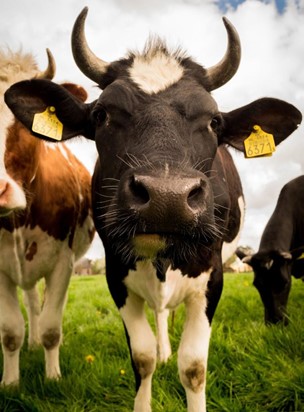Dairy cattle breeds differ in many ways. Some breeds adapt better than others in particular environmental circumstances and the quantities of milk, butter fat and protein content in their milk also vary.
Table 1 gives summarised characteristics of the different dairy cattle breeds in South Africa. The average values for milk production, butterfat content and protein content were obtained from the various cattle breeding societies.
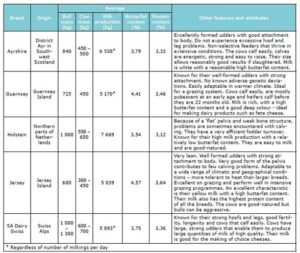
Table 1: The characteristics of different cattle breeds.
Milk production and composition
The following factors have an influence on milk production (Engelbrecht, 1991):
- Lactation stage: After calving, the production increases to reach a peak after 30 to 60 days. A gradual decrease of 5 to 6% per month takes place until the end of the lactation period.
- Feeding and body reserves: The quality and volume of fodder can influence the milk production positively or negatively. Withdrawal of reserves causes a decrease in mass and can have an influence on production.
- Age of the cow.
- Breed of the cow.
- Size of the cow.
- Number of milkings per day. Instead of two milkings per day, three milkings per day can induce an increase in production of 10% to 25%. With two milkings per day, there is no significant difference between 12 hours, 10 to 14 hours, or even 8 to 16-hour intervals between milkings.
- Oestrus.
- Dry periods: The normal lactation period for dairy cattle is 300 days. The ideal calving interval is 365 days. A dry period of approximately 60 days is not only recommended, but it is essential.
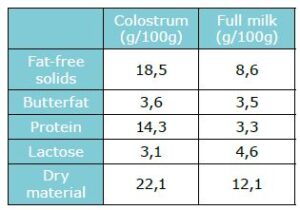
Table 2: The difference in combination of colostrum and full milk (Engelbrecht, 1991). The above values vary in different cattle breeds.
The composition of milk is as follows:
- Water – 87%
- Butter fat – 4%
- Protein – 3,4%
- Lactose – 4,8%
- Minerals – 0,8%
Water requirements
Water is necessary for digestion and body functioning. Insufficient water supply can decrease milk yields. Make sure that the water is cool and sufficient to provide in the cow’s needs. A dairy cow’s appetite for water can be fulfilled long before she reaches her capacity. If the water flows into the trough too slowly, she will be quite satisfied, but her milk yield can decrease with as much as 25%.
The quantity of drinking water needed by a dairy cow depends on the physiological condition of the animal. Age, the tempo of her mass increment, live mass, whether the cow is in the lactating or dry period, and even the breed influences her water needs. Weather conditions play an important role in the quantity of water that a cow will drink.
During hot weather conditions she will drink more to cool down and to compensate for water loss by perspiration. As a rule of thumb, it can be accepted that a cow needs between four and seven litres of water for each kilogram dry fodder eaten. The water content of fodder varies from less than 10% to more than 93%. The higher the water content of the fodder, the less water will be required.
The British Agricultural Research Council (ARC, 1980) gives the following comparison for determining water requirements:
Water intake formula
Where: Iw = water intake (litre)
Id = dry material intake (kg)
M = live mass (kg)
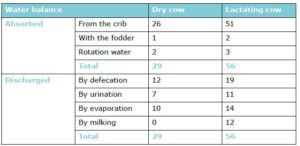
Table 3: Daily water balance.
Table 3 compares the water requirements of a lactating cow with that of a dry cow.
Rotation water is the water released by the breakdown of organic compounds. The breakdown of fats releases reasonably large volumes of water. Note that evaporation water in this study exceeded the water in the milk and that more water was discharged by means of defecation than by urination.
Cows that graze and have access to water day and night, will drink water throughout the day with a noticeable peak after the afternoon milking. Up to 30% of the day’s water intake can take place after the afternoon milking session. Cows drink very little from midnight until after the morning milking. To ensure sufficient water supply, a herd of 100 cows should have a peak requirement of 3 000 litres of water. Water troughs should be large enough to handle this volume of water.
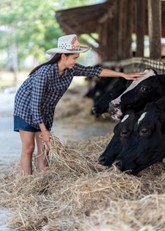
Different volumes of fodder are needed for different lactation and gestation stages.
Fodder requirements
Fodder requirements of dairy cows vary with the stages of lactation and gestation. Five determined feeding phases can be identified to obtain optimal production, reproduction and health of cows:
- Early lactation: 0 to 70 days (peak milk production) after calving
- Peak dry fodder intake: 70 to 140 days (decreasing milk production) after calving
- Middle and late lactation: 140 to 300 days (decreasing milk production) after calving
- Dry period: 60 to 14 days before lactation
- Transition or near-calving period: 14 days before calving
Published with acknowledgement to the ARC Agricultural Engineering for the use of their manuals. Visit www.arc.agric.za for more information.

